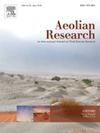Provenance of sediments in a deep-sea core offshore Kangaroo Island spanning the last 125 ka
IF 3.4
3区 地球科学
Q2 GEOGRAPHY, PHYSICAL
引用次数: 0
Abstract
It is common practice nowadays to assess the presence of terrigenous (land-derived) sediments in deep-sea cores using bulk geochemical data, but the key issue is to identify the source of these sediments and the way they were transported to the core site in order to interpret their palaeoclimatic significance. Here, we demonstrate a new approach taken to geochemically-fingerprint a large set of sediments collected from potential source areas (PSAs) in southeastern and southcentral Australia and to compare these data with the record obtained from X-ray Fluorescence (XRF) scanning on a long deep-sea sediment core MD03-2607 obtained offshore Kangaroo Island, South Australia. The entire data set of samples collected on land as well as the downcore measurements were unmixed using the numerical end-member method AnalySize. We successfully use the elements Al, Fe, K, Mn, S, Sr and Y to define end members. In addition, the on-land occurrences of the chemical ratios of Zr/Zn, Ti/Rb, Ti/Y and Zr/Rb are used to support the provenance of the chemical end-members. Three main PSA’s are defined: Murray River Basin (MRB), Darling River Basin (DRB) and Kati Thanda – Lake Eyre District (LED), of which the MRB is represented in two different chemical end members. The downcore contributions of these end members in the sediment core are consequently interpreted in terms of fluvial (MRB and DRB) versus aeolian (LED) input. We determined the origin of the terrigenous sediments recovered from the core for the last glacial-interglacial cycle, with implications for atmospheric circulation across southern Australia.
袋鼠岛近125 ka深海岩心沉积物的物源
目前普遍的做法是利用大量地球化学数据来评估深海岩心中陆源(陆源)沉积物的存在,但关键问题是确定这些沉积物的来源及其运输到岩心地点的方式,以解释其古气候意义。在这里,我们展示了一种新的方法,对从澳大利亚东南部和中南部潜在源区(PSAs)收集的大量沉积物进行地球化学指纹,并将这些数据与从南澳大利亚袋鼠岛近海获得的长深海沉积物岩心MD03-2607上获得的x射线荧光(XRF)扫描记录进行比较。使用数值端元法AnalySize对陆地上收集的整个样本数据集以及岩心测量结果进行了分析。我们成功地使用元素Al, Fe, K, Mn, S, Sr和Y来定义端元。此外,利用Zr/Zn、Ti/Rb、Ti/Y和Zr/Rb化学组分在陆地上的出现情况,支持了化学端元的来源。定义了三个主要的PSA:墨累河流域(MRB),达令河流域(DRB)和卡蒂坦达-艾尔湖区(LED),其中MRB在两个不同的化学末端成员中表示。因此,沉积物岩心中这些末端成员的下岩心贡献被解释为河流(MRB和DRB)与风成(LED)的输入。我们确定了最后一次冰期-间冰期旋回的陆源沉积物的来源,并对南澳大利亚的大气环流产生了影响。
本文章由计算机程序翻译,如有差异,请以英文原文为准。
求助全文
约1分钟内获得全文
求助全文
来源期刊

Aeolian Research
GEOGRAPHY, PHYSICAL-
CiteScore
7.10
自引率
6.10%
发文量
43
审稿时长
>12 weeks
期刊介绍:
The scope of Aeolian Research includes the following topics:
• Fundamental Aeolian processes, including sand and dust entrainment, transport and deposition of sediment
• Modeling and field studies of Aeolian processes
• Instrumentation/measurement in the field and lab
• Practical applications including environmental impacts and erosion control
• Aeolian landforms, geomorphology and paleoenvironments
• Dust-atmosphere/cloud interactions.
 求助内容:
求助内容: 应助结果提醒方式:
应助结果提醒方式:


